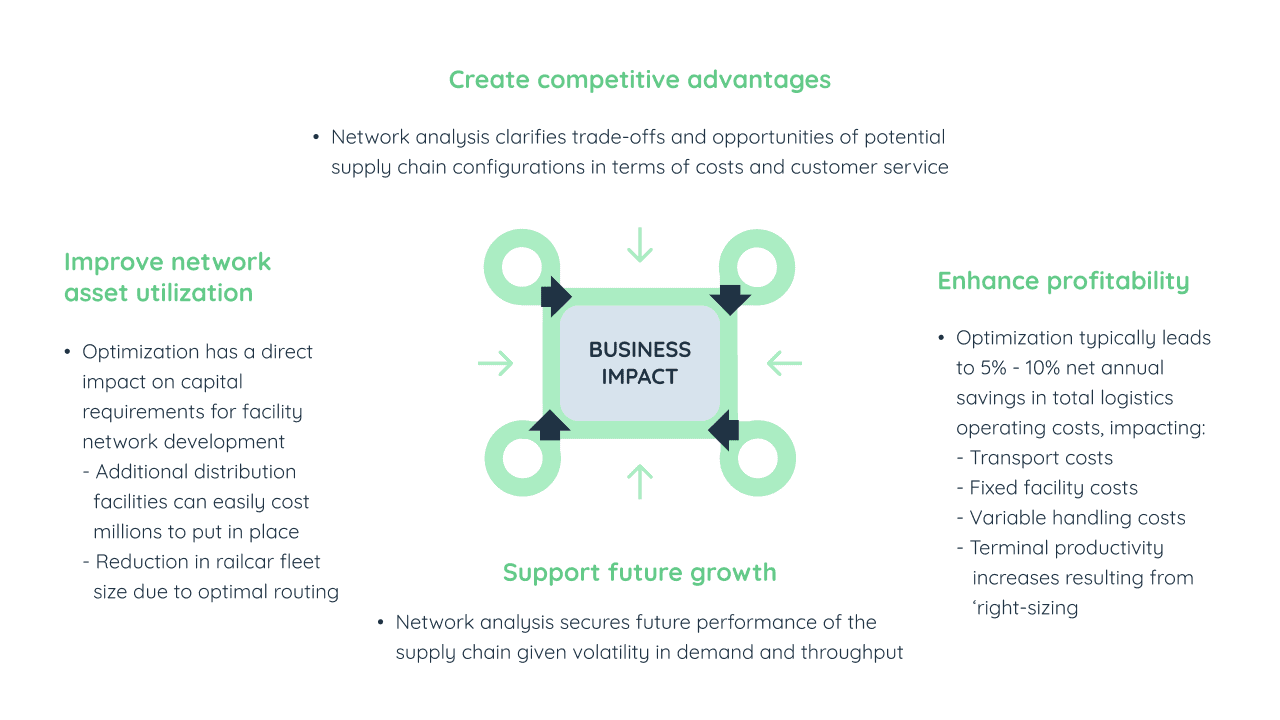Supply chain network design and optimisation starts with today’s complex business landscape and supply chain inefficiencies that create significant challenges for companies, ranging from inventory management issues to distribution bottlenecks. Due to these challenges, the need for strong supply chains has become paramount.
According to a McKinsey survey, 93% of supply chain executives prioritise actions to enhance resilience, focusing on nearshoring and regionalizing supply chains.
Additionally, inventory and network optimisation tools will be widely adopted in the next five years. Hence, it’s evident that optimising supply chain networks holds immense potential for addressing these challenges and unlocking value in uk.
In this article, we delve into why supply chain network design surpasses other investments in supply chain digitisation, offering unparalleled benefits for businesses in today’s competitive landscape.
So, let’s dive!
Scope of Supply Chain Network Optimisation
The goal of Supply chain network design and optimisation uk is to find the most cost-effective and responsive way to deliver products to customers while meeting service-level requirements and minimising risks.
This often requires advanced analytics, mathematical modelling, and simulation techniques to evaluate scenarios and identify the best action.

z Source
Key components of supply chain network optimisation include:
- Demand forecasting: Predicting future product demand to ensure the network can efficiently support customer needs.
- Inventory management: Determining optimal inventory levels and locations to balance customer service levels with inventory holding costs.
- Transportation planning: Selecting the most efficient transportation modes, routes, and carriers to minimise transit times and costs.
- Facility location: Identifying optimal locations for warehouses, distribution centres, and manufacturing facilities to minimise transportation costs and maximise service coverage.
- Supplier and partner collaboration: Working closely with suppliers and other partners to optimise sourcing, production, and distribution processes.
Reasons Why Supply Chain Network Optimisation Outweighs Other Investments in Supply Chain Digitisation
In making supply chains digital, investing in improving how the supply chain network works is incredibly valuable. Among many digital improvements like predicting customer demand or automating warehouses, improving supply chain networking stands out as the key to efficiency and making more money in united kingdom (uk).
Let’s explore why focusing on this area offers more benefits than any other digital investment in supply chains.
Cost Reduction With Supply Chain Network Design And Optimisation
Supply chain network design and optimisation leads the charge in cost reduction initiatives. Unlike standalone investments like warehouse automation, which primarily focus on labour savings within the confines of the warehouse, network optimisation encompasses a holistic approach to cost reduction.
Companies in ukcan achieve significant savings across the entire supply chain network by optimising transportation routes, warehouse locations, and inventory levels.
Related Read: Unleashing Network Optimisation Amid Rapid Market Shifts for Cost Savings and Efficiency Gains
Improved Efficiency
Efficiency gains are inherent to supply chain network design and optimisation. While investments such as transportation management systems (TMS) aim to streamline specific processes within the transportation segment, network optimisation goes beyond siloed improvements.
It orchestrates the flow of goods, information, and finances, eliminating inefficiencies and bottlenecks across the supply chain ecosystem.
Enhanced Customer Service With Supply Chain Network Design And Optimisation
Supply chain network optimisation is synonymous with superior customer service. Unlike demand forecasting and planning, which primarily focus on predicting customer demand, network optimisation ensures timely and accurate fulfilment of customer orders.
Companies can meet customer expectations by optimising inventory levels and distribution networks with faster delivery times and higher product availability.
Reduced Lead Times
Reducing lead times is a crucial advantage of supply chain network optimisation. While investments like supplier relationship management (SRM) aim to strengthen relationships with suppliers, network optimisation takes a proactive approach to minimise lead times at every touchpoint.
By strategically locating facilities and optimising transportation routes, companies in UK can shorten lead times and enhance agility in responding to customer demand fluctuations.
Optimized Inventory Levels
Optimizing inventory levels is a hallmark of supply chain network optimisation. Unlike demand forecasting, which focuses on predicting future demand patterns, network optimisation optimises inventory across the entire supply chain network.
By aligning inventory levels with demand patterns and production capacities, companies can minimise carrying costs while ensuring product availability at the right place and time.
Increased Competitiveness
Supply chain network optimisation is a catalyst for increased competitiveness in UK. While investments like warehouse automation may provide short-term operational efficiencies, network optimisation delivers sustainable competitive advantages.
By fine-tuning the supply chain network, companies can adapt to changing market dynamics, outmanoeuvre competitors, and seize new growth opportunities.
Strategies to Get Most of Supply Chain Network Optimisation
To get the most out of supply chain network optimisation, companies can work on better predicting what customers will want and keeping just enough stock. This way, they can run more smoothly and save money across their supply network.
Demand-Driven Strategies for Enhanced Forecasting Accuracy
Implementing demand-driven strategies means using data and market insights to predict better what customers need. By working closely with sales and marketing teams and using intelligent techniques to understand customer feedback, businesses can ensure they have the right amount of products in stock at the correct times.
This helps to save money on excess stock or running out of products when customers want them.
Lean Inventory Management Techniques to Optimise Stock Levels
Using lean inventory management techniques is about making sure a business has enough stock to meet customer demand without having too much sitting around.
This involves intelligent practices like only ordering what’s needed when needed, working closely with suppliers to keep stock levels in check, and focusing on the products that sell the most.
Using Route Optimisation Software for Efficient Transportation Planning
Route optimisation software helps businesses plan the best way to get products from one place to another. By using intelligent algorithms and considering traffic and environmental impact, companies can ensure their deliveries are fast and efficient.
This saves fuel money and ensures products get to customers on time, which keeps them happy and coming back for more.
Designing Agile Warehouse Networks for Seamless Operations
Creating agile warehouse networks means setting up warehouses to adapt to changes quickly. This includes having flexible layouts and using technology to help move products around quickly.
By doing this, businesses can ensure they can respond quickly to changes in demand and keep costs down by storing only what they need.
Strengthening Supplier Partnerships through Collaborative Planning
Building solid relationships with suppliers is essential for ensuring businesses have what they need when needed.
Companies can avoid delays and keep costs down by working closely with suppliers and sharing information. This also helps suppliers understand what the business needs so they can provide better service and support.
Implementing Risk Mitigation Strategies to Safeguard Against Disruptions
Setting strategies to deal with risks means being prepared for things that might go wrong.
This could include having backup suppliers in case one can’t deliver or having plans for dealing with natural disasters.
Cultivating a Culture of Continuous Improvement to Adapt to Changing Market Dynamics
Encouraging a culture of continuous improvement means always looking for ways to improve things. This could involve getting employee feedback on improving processes or looking for new technologies to make things more efficient.
By constantly looking for ways to improve, businesses can stay ahead of the competition and consistently meet their customers’ needs.
Final Words: Supply Chain Network Design And Optimisation Potential with Sophus Technology
As businesses strive to optimise their supply chain operations, it’s evident that Supply Chain Network Optimisation stands out as a transformative investment. To embark on this journey of unlocking unparalleled value, consider using Sophus Technology, a comprehensive supply chain design and planning platform operating entirely in the cloud.
With its one-stop solution approach and focus on configurability and rapid deployment, Sophus provides supply chain professionals with the tools they need to streamline operations efficiently.









